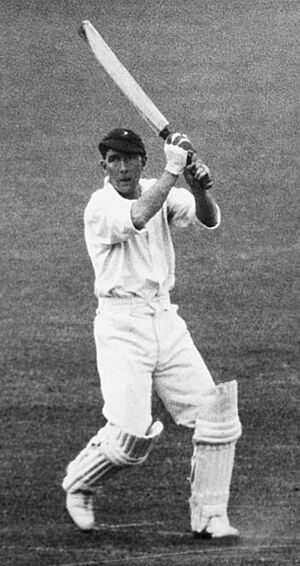Jock Cameron facts for kids

Jock Cameron c. 1930
|
||||||||||||||||||||||||||||||||||||||||
| Personal information | ||||||||||||||||||||||||||||||||||||||||
|---|---|---|---|---|---|---|---|---|---|---|---|---|---|---|---|---|---|---|---|---|---|---|---|---|---|---|---|---|---|---|---|---|---|---|---|---|---|---|---|---|
| Born | 5 July 1905 Port Elizabeth, Cape Colony |
|||||||||||||||||||||||||||||||||||||||
| Died | 2 November 1935 (aged 30) Joubert Park, Johannesburg, South Africa |
|||||||||||||||||||||||||||||||||||||||
| Batting | Right-handed | |||||||||||||||||||||||||||||||||||||||
| Role | Wicketkeeper-batsman | |||||||||||||||||||||||||||||||||||||||
| International information | ||||||||||||||||||||||||||||||||||||||||
| National side | ||||||||||||||||||||||||||||||||||||||||
| Career statistics | ||||||||||||||||||||||||||||||||||||||||
|
||||||||||||||||||||||||||||||||||||||||
|
Source: Cricinfo
|
||||||||||||||||||||||||||||||||||||||||
Jock Cameron (born Horace Brakenridge Cameron, also known as "Herbie") was a talented South African cricketer. He played in the 1920s and 1930s. Many people consider him one of the best wicket-keepers ever. He was also a powerful batsman who could hit the ball very hard. Sadly, he died young, which was a great loss to cricket.
Contents
Early Life and Cricket Beginnings
Jock Cameron loved playing cricket from a young age. He started when he was about ten years old. People encouraged him to become a great wicket-keeper and batsman. Later, he went to Hilton College. There, he played for the school's top cricket team, the 1st XI.
Becoming a Test Cricket Star
Cameron started his professional career with the Transvaal team. From 1925 onwards, he showed how good he was. He was an amazing wicket-keeper and a strong hitter with the bat.
First Test Matches
Because of his skills, Cameron was chosen for the South African team. He played in all five Test matches against England in 1927/1928. This was South Africa's first overseas tour after he joined the team.
Playing in England (1929)
Cameron played so well that he was picked for the 1929 tour of England. He was excellent as a wicket-keeper. He made 57 dismissals and scored 951 runs. During this tour, he had an injury at Lord's cricket ground. A fast ball hit him on the ribs. A special moment was when he made seven dismissals in a game against Somerset.
Captain of South Africa
Cameron became a regular player for the Test team. He moved to the Eastern Province for his business. In 1930/1931, he became the captain of South Africa for the Fourth Test. He had played one game for Western Province before this.
As captain, he scored 69 runs in a tough game. This helped save South Africa and showed his growing batting skills. He could now play defensively as well as hit hard. Cameron also captained South Africa during their tour of Australia and New Zealand in 1931/1932. However, leading the team seemed to affect his batting. He only averaged 15.50 runs against Australia. South Africa lost all five Tests against Australia, who had strong players like Bradman and Grimmett.
Return to Form
Cameron returned to Transvaal for the 1932/1933 season. He could only play once in the next two seasons. But in 1934/1935, he was back to his best. He scored his highest ever score of 182 runs against Griqualand West. He also kept wicket as well as ever.
The 1935 Tour of England
In 1935, Cameron was the vice-captain of the South African team in England. South Africa won the series against England by one Test match to nil. The other four matches were draws.
Cameron's Top Score
In the only match that had a clear winner, played at Lord's, Cameron scored his highest Test score of 90 runs. At one point, he scored 58 of his team's 60 runs in just half an hour! The Cricketer magazine wrote that they had rarely seen a batsman hit the ball so hard with so little effort.
Amazing Hitting Power
During a famous game against Yorkshire, people joked about Cameron's hitting. They said that the bowler, Verity, was unsure if Cameron would hit him for four runs or six runs. Cameron also scored 132 runs against Derbyshire and 160 runs against a team put together by Shrimp Leveson Gower. Louis Duffus wrote that Cameron started his 1935 tour by hitting a ball out of the Worcester ground. From that day, he kept hitting sixes all over the English cricket fields.
A Tragic Loss
When Jock Cameron returned to South Africa, he became very ill. He caught typhoid fever. Sadly, he died less than two months after playing his last cricket game. This was a huge loss for South African cricket.
Impact on South African Cricket
After Cameron's death, South Africa struggled. In 1935–36, they lost four out of five Test matches against Australia. This was partly because of the strong spin bowling of Clarrie Grimmett and Bill O'Reilly. Cameron's powerful hitting might have made their bowling less dangerous. It took South Africa until the 1950s to build a team as strong as the one from 1935.
Remembering Jock Cameron
The Times newspaper wrote about Cameron after he died. They said he had qualities like courage, modesty, generosity, and cheerfulness. These qualities were clear both on and off the cricket field. Everyone who knew him felt his positive influence.
To help Cameron's family, the Australian cricket team played a baseball match. This was during their tour of South Africa in 1935–36. They played against the Transvaal Baseball Club at the Wanderers ground in Johannesburg. The match raised about 400 pounds for his family.

